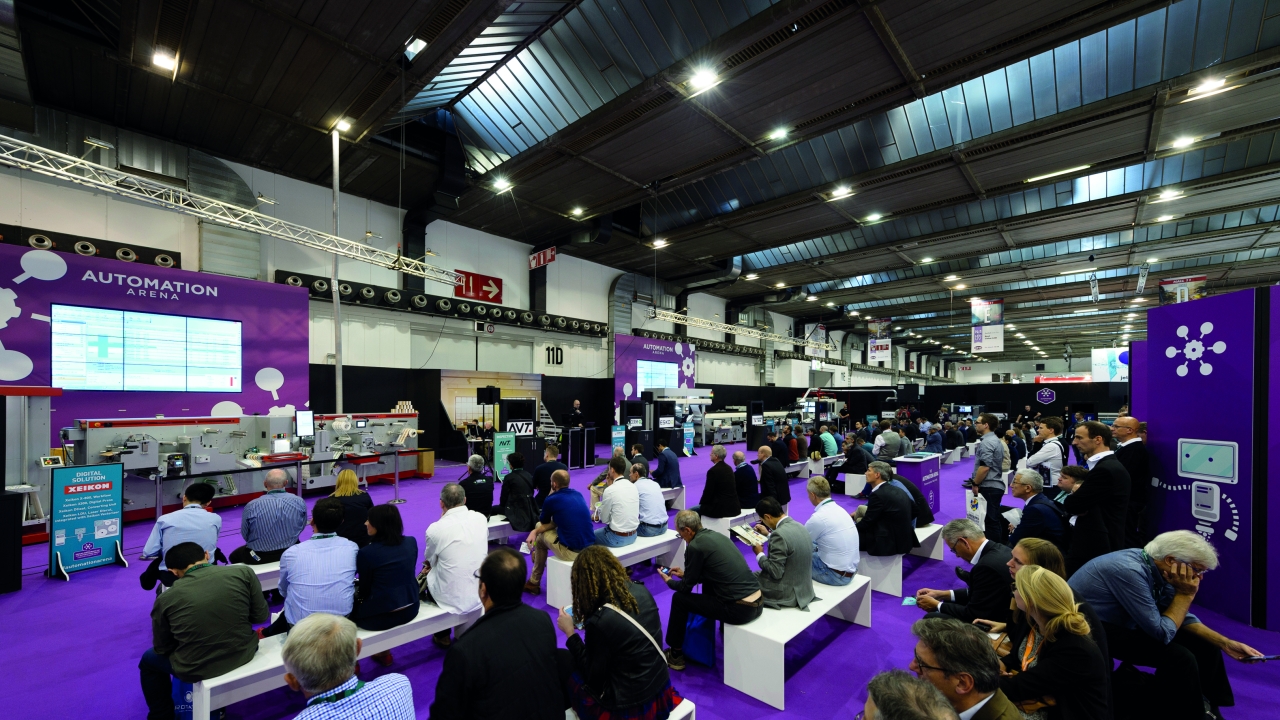A more automated and educated future

Changes and trends that impact on the environment and sustainability, the continued development of digital printing and hybrid press technology, more sophisticated color management, new embellishing techniques, remote diagnostics, internal logistics, ever-more comprehensive management information systems and, of course the fast pace of evolution in business and workflow automation.
Such changes in turn bring new challenges related to finding and recruiting the right level and knowledge of employees, how to educate and train them, the levels of investment required, the growing importance of IT as part of the label workplace, as well as increasing and new ways of serving customers. The divergence of label converters into flexible packaging, shrink sleeve label production, and brand protection technologies, has further impacted on the world of labels.
With pressures growing on the complexity of label and package printing plants, including shorter runs, more varieties and variations, on improving levels of service – all while having to guarantee quality, accurately manage and match colors, provide 100 percent barcode readability, meet BRC food safety requirements, or provide certificates of compliance (CoCs) – it can only be expected that scheduling problems start to occur, production bottlenecks arise and skill and knowledge shortages become compounded.
It was to start addressing many of these growing challenges that the Label Academy was launched some three years ago with just a handful of books. Such has been their success that the number of books already published and in different stages of production now mounts up to 17 or so titles. Initially based on providing technical knowledge on the basic label production technologies such as the conventional printing processes, die-cutting and tooling, label design and origination, label embellishing, etc, the range of topics has now been considerably broadened.
Indeed, the most popular books sold as part of the most recent Labelexpo promotion were Shrink Sleeve Technology, Digital Label and Package Printing, Management Information Systems and Workflow Automation, and Die-Cutting and Tooling. The Encyclopedia of Label Technology also continues to be a best-seller.
To complement the growing range and number of Label Academy books, it was decided to bring Master Classes under the Label Academy banner, with two new subjects being presented and well-attended at Labelexpo Europe: Shrink Sleeve Technology, and Management Information Systems and Workflow Automation. In each case, delegates received a copy of the related technical handbook as part of their delegate fee.
Automation Arena
The MIS book also provided the background to the development and implementation of the Automation Arena at Labelexpo. More than 1,000 visitors attended the Arena presentations during the show, which impressed many with the level of integration between today’s sophisticated Management Information Systems (MIS), advances in workflow automation and the latest developments in automated press, inspection and finishing line set-up.
In each 30 minute demonstration, an audience member ‘customer’ selected both a digital and conventional repeat job label design and was able follow these through all the necessary automated job management, pre-press, remote proofing, print production, inspection and finishing stages, waste removal and warehousing and, finally, through to job delivery and invoicing. Indeed, the whole automation feature was designed to present the printing plant of tomorrow with a level of automation and profitability never before attempted.
From its initial concept, the overall aim of the Automation Arena was to convince converters that with the latest workflow technology it is now easier than ever to automate and process more jobs in the same through-put time, with fewer errors, with 100 percent quality and barcode inspection, incorporate automated press and finishing set-up, and all with the same number of employees.
All nine supplier participants were somewhat overwhelmed with the number of enquiries received from companies now looking to consider automating their operations. A key to the success of the Automation Arena was the collaboration between all the participating companies, managed in turn by the Cerm MIS.
Whilst the Automation Arena, supplemented by the Management Information Systems and Workflow Automation handbook and dedicated master class, have become undoubted successes in showing what can be achieved in today’s fast changing label and package printing world, it is still only a foretaste of what will become possible in terms of business and workflow automation in the coming one to two years – and what will become necessary in terms of recruitment, education and training.
Although not shown in the Automation Arena, color formulation, ink mixing and dispensing, tracking and reporting are already being connected directly to MIS, with digitally defined and accurately reproduced spot colors being produced in less than three minutes. Color information resides in a secure centralized cloud-based system which can be accessed by the printer, brand owner, designer and others in the supply chain.
Follow up discussions since Labelexpo already indicate that production and workflow automation is continuing to evolve rapidly. Indeed, the next few years are expected to see the ongoing and extended integration of MIS with mounting, set-up and registration of plates, as well as more and more automated finishing operations, including turret rewinding, slitting, laser die-cutting, spot UV varnishing, visual and tactile enhancements, cold foiling, Braille and variable data printing. Other developments will see MIS integrated with on-press guaranteed UV LED ink cure being tracked and recorded.
Change
Internal company logistics are also certainly going to change. The use of RFID tags placed on pallets, fork or lift trucks and racking will complement roll tracking and further automate handling and storage operations, perhaps even to the extent of robotic movement of inks, reels, plates and other consumables to presses. Press manufacturers increasingly already provide remote diagnostics, service history, performance analysis, etc, with their equipment. This too is expected to be integrated with converter MIS for tracking, recording and analysis.
With the more sophisticated MIS systems today it is already possible using laptops or hand-held devices to login and track company performance, individual jobs, schedules, profitability – and much more – from almost anywhere in the world. More and more employees will also be expected to be able to access elements of their company’s management and performance on line. Computer and IT skills will certainly become ever more important.
Put all these current and future business and workflow automation features together and we now start to look at MIS automatically producing Certificates of Compliance, BRC certification, ISO quality performance, etc, at the end of each production run and sending all the customer quality and compliance data to the customer with all the required shipping and delivery tracking data.
At the same time, MIS financial software will be able to provide the management team with information on things like gross margins, break even points, net profits and return on assets – all of which should highlight areas for potential growth or underperformance.
In an era of ever decreasing run lengths, production bottlenecks, shorter lead and delivery times, multi-versions and variations, it seems certain that increasing automation of tomorrow’s label and package printing plants will become not only a nice investment but also a necessity for successful performance and profitability.
What is also becoming a necessity is the need for enhanced education and training, better knowledge and skills learning, improved recruitment procedures and more professional employee revues and job development programs. IT knowledge and skills will become ever more important. IT departments will get bigger. Automation will become the key to profitability. The challenges will grow.
New initiatives by the Label Academy and with the industry associations, educators and training organizations are ongoing to meet these industry challenges. The Label Academy books and Master Classes are already beginning to have an impact, the Automation Arena has undoubtedly opened many eyes to a new automated future. Workshops will have a growing role. More such events of all kinds will certainly be required in the coming years. New Academy books, new Master Classes, new education and training courses will certainly come. Pressure to create a degree-level initiative will undoubtedly grow.
The label and package printing sectors are the fastest growth sectors in the whole of the printing industry. They are exciting, fast changing, rapidly evolving. They need new generations of employees with knowledge and skills in areas of print never seen before. The pace of change in these industries will be quite dramatic over the next few years – but they have a future. A challenging and changing automated future. Let’s make sure we get it right.
This opinion article was first published in the 2018 L&L Yearbook, available to read online here
Stay up to date
Subscribe to the free Label News newsletter and receive the latest content every week. We'll never share your email address.


